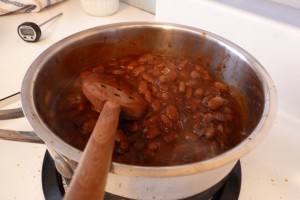 There is something miraculous about baked beans, or “brown beans,” as I know them. You take legumes that usually disintegrate when overcooked, and by adding a special blend of ingredients, you can suddenly stew them almost indefinitely without compromising their shape and texture. There are in fact three magic ingredients in this potion:
There is something miraculous about baked beans, or “brown beans,” as I know them. You take legumes that usually disintegrate when overcooked, and by adding a special blend of ingredients, you can suddenly stew them almost indefinitely without compromising their shape and texture. There are in fact three magic ingredients in this potion:
- acids, usually in the form of tomato, mustard, or vinegar, “make the cell-wall hemicelluloses [in the beans] more stable and less dissolvable”;[1]
- sugar, in the form of molasses, maple syrup or, um, sugar, “helps reinforce cell-wall structure and slows the swelling of the starch granules”;[2]
- calcium, usually in the form of molasses and brown sugar, “cross-links and reinforces cell-wall pectins”.[3]
Since these ingredients prevent further softening and degradation of the beans, the most important part of the preparation of baked beans is simmering the beans before hand. If the beans are undercooked and tough, they’re not going to get any softer during the bake!
The Beans. You can use any variety you choose, but I prefer pintos. They’re a bit larger than classic varieties and have a creamy texture. I also like Cherokees.
Use only enough water to cover the beans. The flavour, colour, and nutrients of beans leach into the cooking liquid, and the more liquid there is, the more you will lose. During cooking, water will be sucked up by the beans and driven into the air, so you’ll have to top up the water level periodically.
Simmer the beans very gently. The skin of the bean, called the seed coat, is analogous to the bran on grains like rice and barley and keeps the bean intact during cooking. The agitation caused by aggressive boiling will rupture many of the seed-coats and make the beans split and disintegrate.
I always get a little anxious when cooking a steak: there’s a correct level of doneness, and to remove the meat from the grill before or after that point means you’ve spoiled it to one degree or another. I feel the same way with beans. There is a point in time when they are very tender and creamy inside, but still perfectly intact. Remove the beans immediately, drain, and rinse with cold water.
The Bake. One of the hallmarks of baked beans is the balance of sweet and savoury. Commercial brands of brown beans tend to be overly sweet. Even the cans that have those little pieces of mushy bacon taste very little of bacon.
In most parts of North America the classic sweetener is molasses (or brown sugar, which contains molasses). “Baking molasses” has a distinct flavour reminiscent of baking soda, so I use “fancy molasses,” which is much more palatable. If you replace the molasses in the recipe below with maple syrup, you will have the fèves au lard of Quebec, or the brown beans of eastern Ontario.
As noted above, molasses also contributes calcium which helps preserve bean structure during extending baking.
The savoury side of the equation is always dominated by pork. Baked beans are a fantastic conveyance for all things pork. Salt pork is a classic. I start by frying bacon, then cook the onions and garlic in the drippings.
The body of the brown beans described below comes from a pork reduction, pork stock boiled vigorously until it is maybe a tenth of its original volume. Besides contributing depth of flavour, it helps thickens the sauce.
A crock of baked beans is also a good place to throw any number of pork bits that might usually be reserved for broth. Bacon rind, for instance. When I make bacon I usually leave the skin on during the curing and smoking, because it comes away so easily after the belly is cooked in the smoker. I then have a sheet of cured, smoked pork skin that boosts the flavours already present in the beans.
Truly, truly one of the supreme accompaniments to pork chops.
Brown Beans
Ingredients
- 1 lb dry pinto beans
- 10 oz bacon, cut into lardons
- 6 oz onion, fine dice
- 1/2 oz garlic, minced
- 2/3 cup dry cider or dry white wine
- 1/3 cup tomato paste
- 1/3 cup fancy molasses
- 1/3 cup dark brown sugar
- 1/3 qt pork reduction
- 1 tbsp cider vinegar
- bacon rind
- bay
- thyme
- kosher salt
Procedure
- Optional: Soak the beans overnight in lots of water. This will reduce simmering time.
- The next day, transfer the beans to a large pot. Add enough cold water that the beans are just, just covered. Bring to a boil and simmer gently until the beans are tender, about 45 minutes. Note that the beans will not cook any further in the subsequent baking process!
- Strain the beans and refresh with cold water.
- In a braising pot, fry the lardons until golden and slightly crisp. Sweat the onions and garlic in the pan drippings until translucent. Add the cider or wine. Crank the heat and reduce the liquid to 1/4 of its original volume.
- Add the tomato paste, molasses, brown sugar, pork reduction, vinegar, and bay. Bring the liquid to a simmer. Add the beans and rind and return to a simmer.
- Simmer gently until the sauce has reduced and clung to the beans, at least 2 hours. Add the thyme for the last 15 minutes of simmering.
- Remove the bay, rind, and thyme. Taste the beans and add salt as required.
- Eat with pork and toast, as shown below.
References
- McGee, Harold. On Food and Cooking. ©2004 Scribner, New York. Page 488.
- Ibid.
- Ibid.
